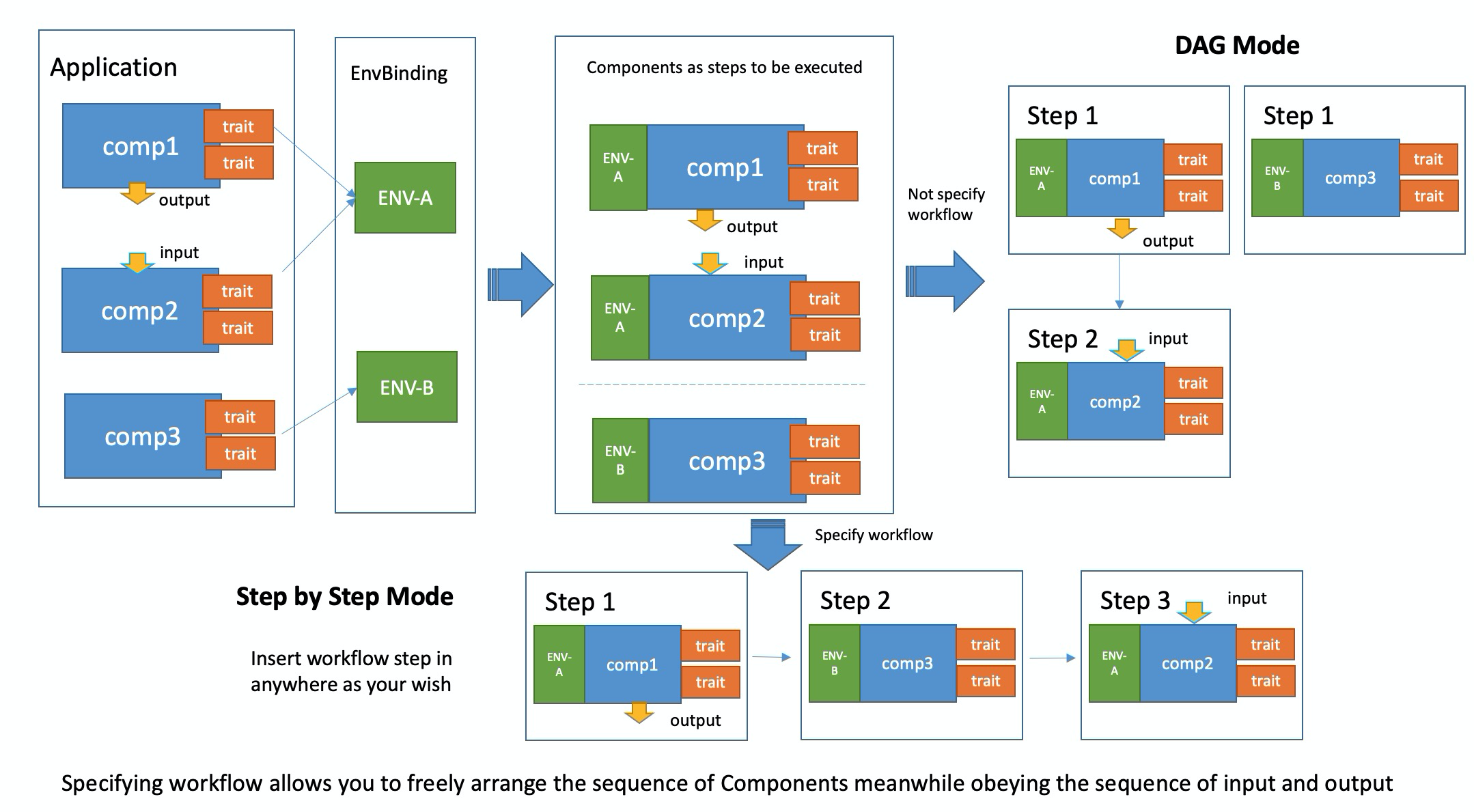Multi-Cluster App Delivery
This section will introduce how to use KubeVela for multi-cluster application delivery and why.
Introduction
There are more and more situations come out that organizations need multi-cluster technology for application delivery:
- For scalability, a single Kubernetes cluster has its limit around 5K nodes or less, it is unable to handle the large scale application load.
- For stability/availability, application can deploy in multi-cluster for backup which provides more stability and availability.
- For security, you may need to deploy in different zones/areas as government policy requires.
The following guide will the multi-cluster that helps you easily deploy an application to different environments.
Preparation
You can simply join an existing cluster into KubeVela by specify its KubeConfig like below.
vela cluster join <your kubeconfig path>
It will use field context.cluster in KubeConfig as the cluster name automatically,
you can also specify the name by --name parameter. For example:
vela cluster join stage-cluster.kubeconfig --name cluster-staging
vela cluster join prod-cluster.kubeconfig --name cluster-prod
After clusters joined, you could list all clusters managed by KubeVela currently.
$ vela cluster list
CLUSTER TYPE ENDPOINT
cluster-prod tls https://47.88.4.97:6443
cluster-staging tls https://47.88.7.230:6443
You can also detach a cluster if you're not using it any more.
$ vela cluster detach cluster-prod
If there's still any application running in the cluster, the command will be rejected.
Deploy Application to multi cluster
KubeVela regards a Kubernetes cluster as an environment, so you can deploy an application into one or more environments.
Below is an example, deploy to a staging environment first, check the application running well, and finally promote to production environment.
For different environments, the deployment configuration can also have some nuance. In the staging environment, we only need one replica for the webservice and do not need the worker. In the production environment, we setup 3 replicas for the webservice and enable the worker.
apiVersion: core.oam.dev/v1beta1
kind: Application
metadata:
name: example-app
namespace: default
spec:
components:
- name: hello-world-server
type: webservice
properties:
image: crccheck/hello-world
port: 8000
traits:
- type: scaler
properties:
replicas: 1
- name: data-worker
type: worker
properties:
image: busybox
cmd:
- sleep
- '1000000'
policies:
- name: example-multi-env-policy
type: env-binding
properties:
envs:
- name: staging
placement: # selecting the cluster to deploy to
clusterSelector:
name: cluster-staging
selector: # selecting which component to use
components:
- hello-world-server
- name: prod
placement:
clusterSelector:
name: cluster-prod
patch: # overlay patch on above components
components:
- name: hello-world-server
type: webservice
traits:
- type: scaler
properties:
replicas: 3
- name: health-policy-demo
type: health
properties:
probeInterval: 5
probeTimeout: 10
workflow:
steps:
# deploy to staging env
- name: deploy-staging
type: deploy2env
properties:
policy: example-multi-env-policy
env: staging
# manual check
- name: manual-approval
type: suspend
# deploy to prod env
- name: deploy-prod
type: deploy2env
properties:
policy: example-multi-env-policy
env: prod
After the application deployed, it will run as the workflow steps.
You can refer to Env Binding and Health Check policy user guide for parameter details.
It will deploy application to staging environment first, you can check the Application status by:
> kubectl get application example-app
NAME COMPONENT TYPE PHASE HEALTHY STATUS AGE
example-app hello-world-server webservice workflowSuspending true Ready:1/1 10s
We can see that the workflow is suspended at manual-approval:
...
status:
workflow:
appRevision: example-app-v1:44a6447e3653bcc2
contextBackend:
apiVersion: v1
kind: ConfigMap
name: workflow-example-app-context
uid: 56ddcde6-8a83-4ac3-bf94-d19f8f55eb3d
mode: StepByStep
steps:
- id: wek2b31nai
name: deploy-staging
phase: succeeded
type: deploy2env
- id: 7j5eb764mk
name: manual-approval
phase: succeeded
type: suspend
suspend: true
terminated: false
waitCount: 0
You can also check the health status in the status.service field below.
...
status:
services:
- env: staging
healthy: true
message: 'Ready:1/1 '
name: hello-world-server
scopes:
- apiVersion: core.oam.dev/v1alpha2
kind: HealthScope
name: health-policy-demo
namespace: test
uid: 6e6230a3-93f3-4dba-ba09-dd863b6c4a88
traits:
- healthy: true
type: scaler
workloadDefinition:
apiVersion: apps/v1
kind: Deployment
You can use resume command after everything verified in statging cluster:
> vela workflow resume example-app
Successfully resume workflow: example-app
Recheck the Application status:
> kubectl get application example-app
NAME COMPONENT TYPE PHASE HEALTHY STATUS AGE
example-app hello-world-server webservice running true Ready:1/1 62s
status:
services:
- env: staging
healthy: true
message: 'Ready:1/1 '
name: hello-world-server
scopes:
- apiVersion: core.oam.dev/v1alpha2
kind: HealthScope
name: health-policy-demo
namespace: default
uid: 9174ac61-d262-444b-bb6c-e5f0caee706a
traits:
- healthy: true
type: scaler
workloadDefinition:
apiVersion: apps/v1
kind: Deployment
- env: prod
healthy: true
message: 'Ready:3/3 '
name: hello-world-server
scopes:
- apiVersion: core.oam.dev/v1alpha2
kind: HealthScope
name: health-policy-demo
namespace: default
uid: 9174ac61-d262-444b-bb6c-e5f0caee706a
traits:
- healthy: true
type: scaler
workloadDefinition:
apiVersion: apps/v1
kind: Deployment
- env: prod
healthy: true
message: 'Ready:1/1 '
name: data-worker
scopes:
- apiVersion: core.oam.dev/v1alpha2
kind: HealthScope
name: health-policy-demo
namespace: default
uid: 9174ac61-d262-444b-bb6c-e5f0caee706a
workloadDefinition:
apiVersion: apps/v1
kind: Deployment
All the step status in workflow is succeeded:
...
status:
workflow:
appRevision: example-app-v1:44a6447e3653bcc2
contextBackend:
apiVersion: v1
kind: ConfigMap
name: workflow-example-app-context
uid: e1e7bd2d-8743-4239-9de7-55a0dd76e5d3
mode: StepByStep
steps:
- id: q8yx7pr8wb
name: deploy-staging
phase: succeeded
type: deploy2env
- id: 6oxrtvki9o
name: manual-approval
phase: succeeded
type: suspend
- id: uk287p8c31
name: deploy-prod
phase: succeeded
type: deploy2env
suspend: false
terminated: false
waitCount: 0
More use cases
KubeVela can provide many strategies to deploy an application to multiple clusters by composing env-binding policy and workflow steps.
You can have a glimpse of how does it work as below:

More use cases about the multi cluster application deployment are coming soon.